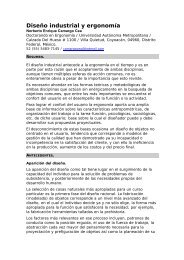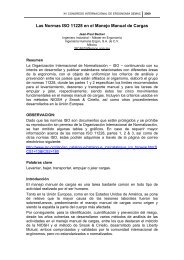ERGONOMÍA OCUPACIONAL - SOCIEDAD DE ERGONOMISTAS ...
ERGONOMÍA OCUPACIONAL - SOCIEDAD DE ERGONOMISTAS ...
ERGONOMÍA OCUPACIONAL - SOCIEDAD DE ERGONOMISTAS ...
You also want an ePaper? Increase the reach of your titles
YUMPU automatically turns print PDFs into web optimized ePapers that Google loves.
4.1 Preliminary test 1<br />
Ergonomía Ocupacional. Investigaciones y Aplicaciones. Vol 3 2010<br />
The corresponding temperature behavior is shown in Figure 1 and 2. If we compare both figures<br />
we can see that both temperature behaviors in both wrists are very but very similar. Three similar<br />
characteristics were identified as a result:<br />
• The temperatures in both writs (maximum stress points) were 33.44˚C and 32.921˚C, and were<br />
reached at similar periods of time, 11:41:14 and 11:49:28 (h:m:s).<br />
• The anomalies in right shoulder started to being shown by the person at the range where were<br />
the highest temperature levels, while doing the operation using both wrists.<br />
• The most aggressive projection of the temperature was approximately at 11:30 and 12:00 in<br />
both wrists.<br />
In both cases the subject beated the pain symptoms on right shoulder, this happened when the<br />
most aggressive projection began to appear, approximately at 11:40. Then at the same time the<br />
temperature projection became less aggressive and began a tendency of decrease.<br />
On the other hand, by adjusting a third order equation it was possible to explain the temperatures<br />
of the person with a coefficient of determination of 91.1% for the left hand wrist and 87.7% for the<br />
right hand wrist.<br />
Figure 1. Adjustment of the curve of left hand wrist<br />
Sociedad de Ergonomistas de México, A.C. 120




